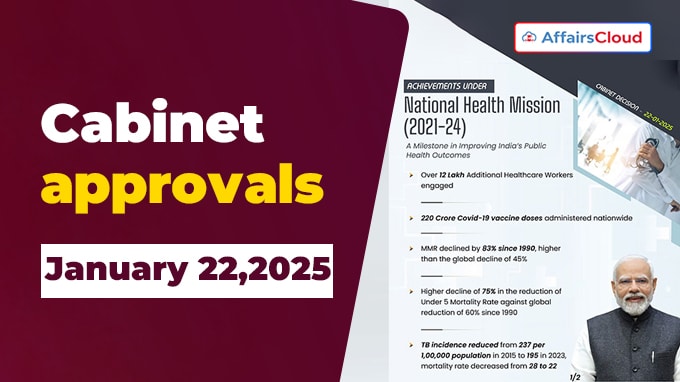
On January 22 2025, the Union Cabinet, chaired by Prime Minister (PM) Narendra Modi has approved the following proposals:
i.Apprised of Achievements under National Health Mission (NHM) (2021-24). It has also approved continuation of the NHM for another 5 years.
ii.Approved the Minimum Support Price (MSP) of Rs 5,650 per quintal for raw jute (TD-3 grade) for marketing season 2025-26. This marks an increase of nearly 6% i.e. Rs 315 per quintal compared to last marketing season 2024-25.
Cabinet Apprised of Achievements under NHM (2021-24): A Milestone in Improving India’s Public Health Outcomes
The Union Cabinet was apprised of the achievements under the National Health Mission (NHM) during a period of 3 years (from 2021-22 to 2023-24).
- It was also apprised of accelerated decrease in Maternal Mortality Rate (MMR), Infant Mortality (IMR), Under-5 Mortality Rate (U5MR), and Total Fertility Rate (TFR).
- It has also approved continuation of the NHM for another 5 years.
Key Progress Made under NHM
i.NHM provided the engagement of 2.69 lakh additional healthcare workers, in Financial Year 2021-22 (FY22). Also, 90,740 Community Health Officers (CHOs) were engaged.
ii.The NHM framework has also played an instrumental role in strengthening the public health system, especially in response to the COVID-19 pandemic.
- NHM was crucial in administering more than 220 crore COVID-19 vaccine doses between January 2021 and March 2024.
iii.MMR has decreased significantly by 25%, from 130 lakh live births (in 2014-16) to 97 per lakh(in 2018-20). It has decreased by 83% since 1990, which is higher than the global decline of 45%.
iv.U5MR has also declined from 45 per 1,000 live births (in 2014) to 32 (in 2020), which reflects a higher decline of 75% in the reduction of mortality when compared with the global reduction of 60% since 1990.
v.IMR has decreased from 39 per 1,000 live births (in 2014) to 28 (in 2020). Also, TFR declined from 2.3 (in 2015) to 2.0 (in 2020), as per the National Family Health Survey (NFHS-5) .
- These improvements reflect that India is on track to meet its United Nations (UN) Sustainable Development Goals (SDGs) targets for maternal, child, and infant mortality well ahead of 2030.
Key Progress in eliminating and controlling various diseases:
NHM has played an important role in the elimination and control of various diseases such as:
i.Under the National Tuberculosis Elimination Programme (NTEP), the incidence of Tuberculosis (TB) has decreased from 237 per 1 lakh population (in 2015) to 195 (in 2023), and similarly, the mortality rate has declined from 28 to 22 during the same period of time.
ii.The malaria cases and deaths have declined 13.28% and 3.22% respectively, in 2021 as compared to 2020.
- Malaria surveillance and cases have increased by 32.92% and 9.13% respectively in 2022, whereas malaria deaths have declined by 7.77% as compared to 2021.
- For the year 2023, malaria surveillance and cases have increased by 8.34% and 28.91% respectively as compared to 2022.
iii.Also, GoI’s efforts to eliminate Kala-azar have been successful, with 100% of endemic blocks achieving the target of less than 1 case per 10,000 population by the end of 2023.
iv.The Measles-Rubella Elimination Campaign, under the Intensified Mission Indradhanush (IMI), has vaccinated more than 34.77 crore children, achieving a 97.98% coverage.
Progress Made by Key Initiatives launched under NHM:
i.Pradhan Mantri TB Mukt Bharat Abhiyan, launched in September 2022, has witnessed the registration of 1,56,572 Ni-kshay Mitra volunteers who have supported more than 9.40 lakh TB patients.
ii.Pradhan Mantri National Dialysis Programme (PMNDP) has also been expanded, with more than 62.35 lakh hemodialysis sessions provided in FY24, which has benefitted over 4.53 lakh dialysis patients.
iii.In 2023, GoI launched the National Sickle Cell Anemia Elimination Mission, which has screened over 2.61 crore individuals in tribal areas, this progress will help in achieving the target of eliminating sickle cell disease by 2047.
iv.U-WIN platform launched in January 2023, aimed to ensure the timely administration of vaccines to pregnant women, infants, and children across India.
- The platform had expanded to 65 districts across 36 states/Union Territories (UTs) by the end of FY24, ensuring real-time vaccination tracking and improving immunization coverage.
Other Key Points:
i.The NHM has also emphasized on strengthening healthcare infrastructure, including the certification of public health facilities under the National Quality Assurance Standards (NQAS).
- As of March 2024, 7,998 public health facilities have been certified, with more than 4,200 of them receiving national certification.
ii.Also, the number of operational Ayushman Arogya Mandir (AAM) centers, which offer a range of health services, has increased to 1,72, 148 by the end of FY24, with 1,34, 650 of these centers providing 12 key healthcare services.
iii.By March 2024, 12, 348 Primary Health Centers (PHCs) had been converted to 24×7 services, and 3,133 First Referral Units (FRUs) were operational across the country.
- Additionally, the fleet of Mobile Medical Units (MMUs) has expanded, with 1,424 MMUs now operating to ensure healthcare access in remote and underserved areas.
Background:
i.In 2005, GoI launched the National Rural Health Mission (NRHM) with the objective of building public health systems to provide accessible, affordable and quality healthcare to the rural population.
ii.The National Urban Health Mission (NUHM) was conceptualized in 2012 and the NRHM was later rebranded as the NHM with two sub-missions i.e. NRHM and the NUHM.
iii.In 2018, the Union Cabinet approved the continuation of NHM, with effect from 1st April, 2017 to 31st March, 2020.
- Later, in 2022, Department of Expenditure (DoE), Ministry of Finance (MoF) has further accorded the approval for continuation of NHM from 1st April, 2021 to 31st March, 2026.
iv.The implementation strategy of Ministry of Health and Family Welfare (MoH&FW) under NHM is to facilitate financial and technical support to States/ Union Territories (UTs) enabling them to offer accessible, affordable, accountable and effective healthcare up to District Hospitals (DHs), especially to the poor and vulnerable sections of the population.
CCEA Approved Rs 5,650 per Quintal MSP for Raw Jute for 2025-26 Season
The Cabinet Committee on Economic Affairs (CCEA), chaired by PM Narendra Modi approved the Minimum Support Price (MSP) of Rs 5,650 per quintal for raw jute (TD-3 grade) for marketing season 2025-26. This marks an increase of nearly 6% i.e. Rs 315 per quintal compared to last marketing season 2024-25.
- This increase in MSP for raw jute would ensure a return of 66.8% over the all India weighted average cost of production.
Key Points:
i.Also, this new approved MSP for raw jute is in line with the principle of fixing MSP at a level of minimum 1.5 times all India weighted average cost of production as announced by the Government of India (GoI) in the Union Budget for FY19 (2018-19).
ii.The GoI has increased MSP of raw jute by 2.35 times (Rs 3,250 per quintal), from Rs 2,400 per quintal (in 2014-15 season) to Rs 5,650 per quintal (2024-25 season).
iii.The Government revealed that the MSP amount paid to jute growing farmers during the period 2014-15 to 2024-25 was Rs 1,300 crore compared to Rs 441 crore paid to jute growing farmers during the period 2004-05 to 2013-14.
Note: Kolkata (West Bengal, WB)-based Jute Corporation of India (JCI) will continue to act as nodal agency to undertake Price Support Operations and the losses incurred, if any in such operations, will be completely reimbursed by the GoI.




